Rolling stock


uST Transport & Infrastructure Complexes ensure passenger and cargo transportation by means of rolling stock, namely, unmanned steel-wheeled rail electric cars (uPods)
Basic modules
Traction module
Provides all travel modes of uPod along the track structure of the transport complex
Traction drive system
Braking system
Heading-hold system
Vehicle evacuation system and fire extinguishing system
Passenger module
Designed to locate passengers and their luggage, protect and create safe and comfortable conditions for their stay inside while traveling and at stops, including emergency ones
Entrance system (door system)
Ventilation and microclimate system
Interior with seats (if needed), handrails, handicapped space
Passenger information system (video and duplex communication with the operator)
Lighting system (working and emergency)
Information plates, indicator lights
Passenger evacuation system to the ground
Fire fighting equipment (fire extinguishers)
Onboard control system
OCS is a set of hardware and software designed to control uPod and ensure safe traffic conditions.
OCS consists of several functional systems that perform all necessary control and safety functions
Automatic uPod protection system
Automatic uPod train operation (ATO)
Automatic uPod train control and management system (TCMS)


uPod
Onboard control system
Power supply system
Passenger module
Traction module
Implemented Configurations of Rail Electric Vehicles
UST Inc. developed a set of generic (tested and certified) structural and technological solutions for the creation of uST Transport Complexes. They allow performing various tasks in passenger and cargo transportation. Depending on customer requests and climatic conditions, uST rolling stock can come in different configurations. When coupled in small trains, the passenger models of uPods can carry up to 50,000 people per hour. Cargo transport is capable of handling up to 100 million tons pef cargo per year.
uPods, including those assembled in trains, can have different capacities – from 2 to 250 passengers. Their design allows the individual modules to be coupled into a single train through a rigid or electronic coupler. The number of sections and their capacity depends on the expected passenger flow. The vehicles are driven by the electric traction drive. Automated control system ensures speed and route control. The maximum speed is 150 km/h.
uST transport can handle different types of cargo: bulk (loose), liquid, breakbulk, special, as well as sea containers of 20 to 40 feet in nominal length. Their loading and unloading is automatic. The maximum speed of transportation is 150 km/h. Automated control system ensures speed and route control
Passenger Transport
-
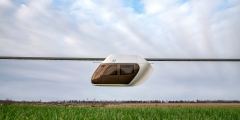
uBike U4-621
-
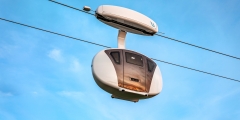
uWind U4-651
-
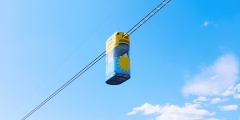
uLite U4-830
-
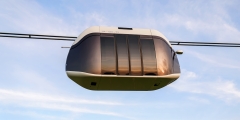
uCar U4-430
-
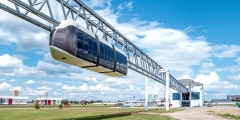
uCar U4-430-Т3
-
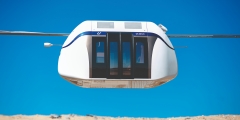
uCar U4-431
-
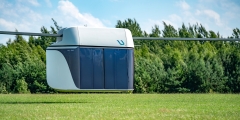
uBus U4-210
-
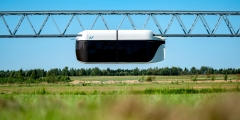
uBus U4-220
-
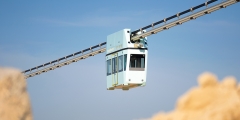
uBus KARAT U4-212
-
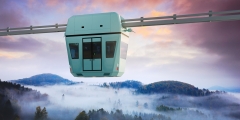
uBus KARAT U5-543
-
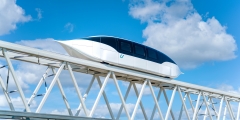
uFlash U4-362
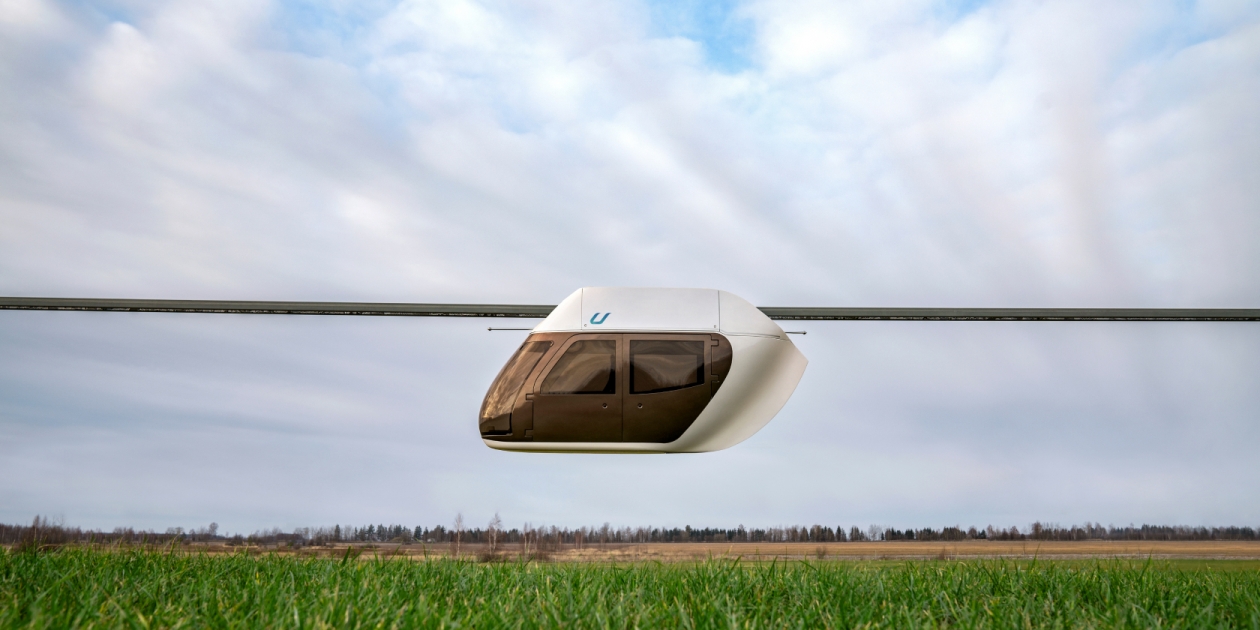
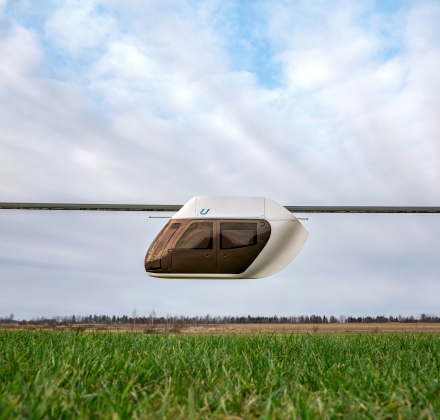
uBike U4-621
Double-rail suspended passenger uPod of small capacity. In the basic configuration, the seats are located sequentially providing zoning of seats and an increased comfort. The optimal weight of uBike allows to use it on a lightweight track structure, that makes it possible to use this transport as part of complexes with a minimum material consumption of the structure. uBike can be used for transportation in recreation areas, on tourist and other routes. In addition to on-board (and external) energy sources, it is possible to install a bicycle generator, thanks to which uBike can be driven by the passengers’ muscular power.
Features
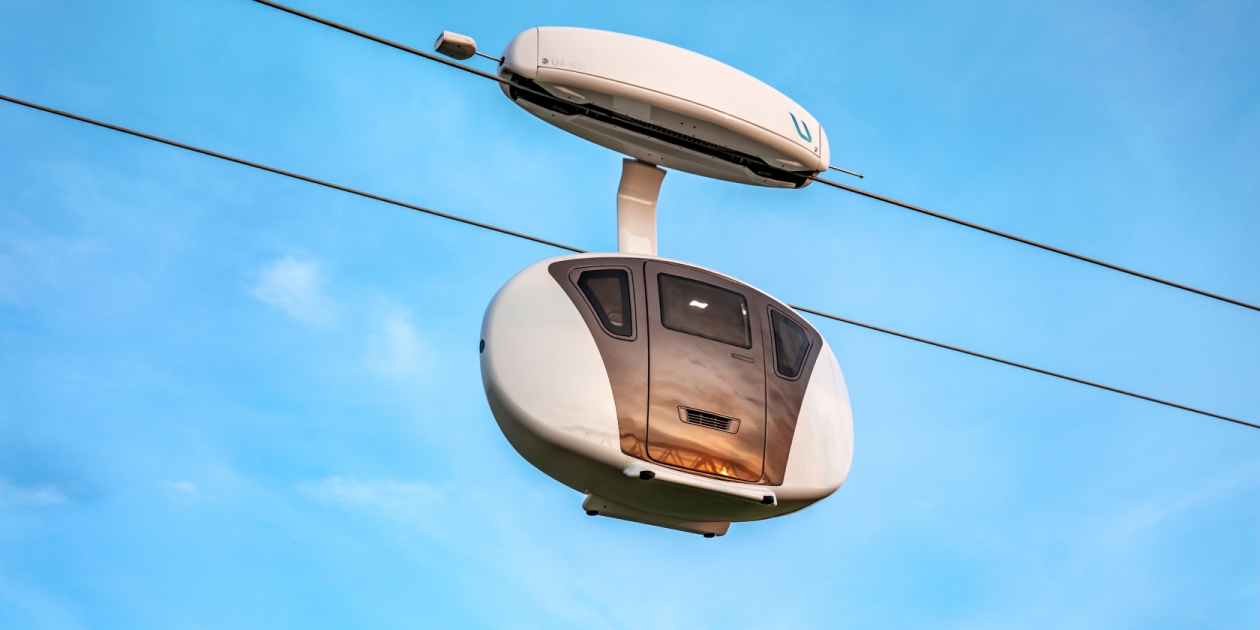
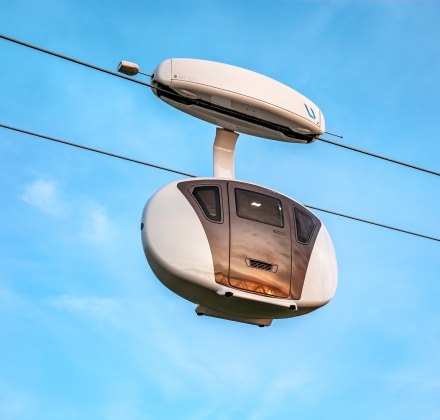
uWind U4-651
Monorail suspended uPod of small capacity with running gear designed for passenger transportation. In the basic configuration, the passenger seats are located opposite each other. The small mass of uWind allows it to move along a lightweight string-rail overpass, that makes it possible to use uPod as part of complexes characterized by minimal material consumption of structures. It is designed to provide connection with sparsely populated and remote areas.
Features
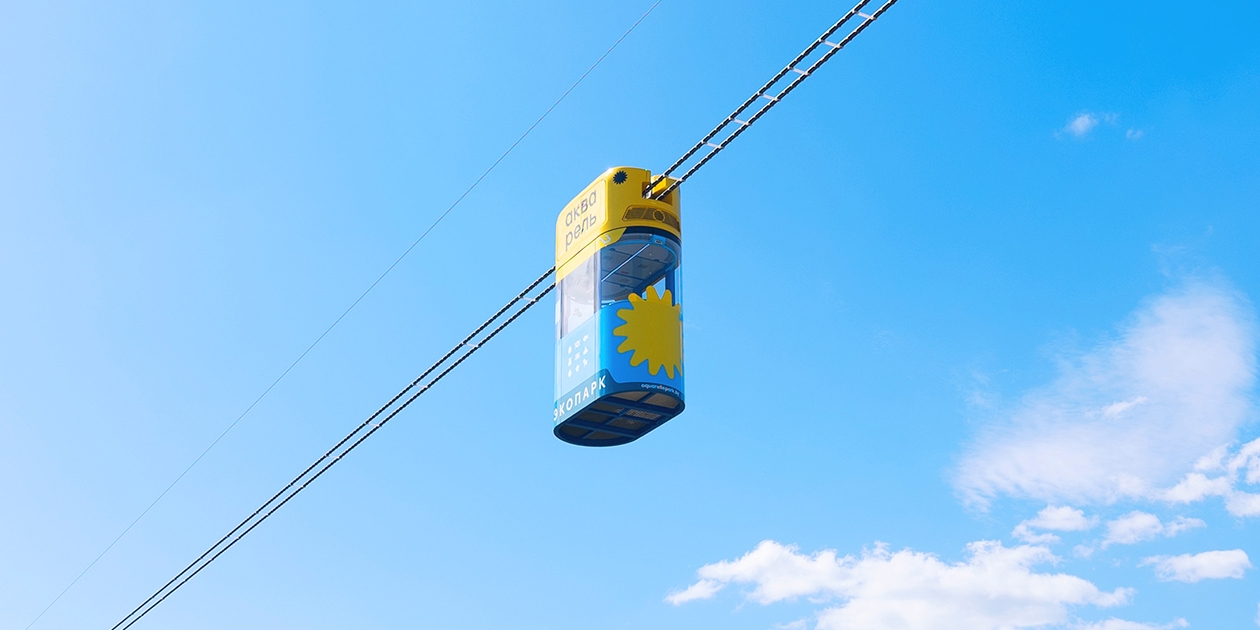
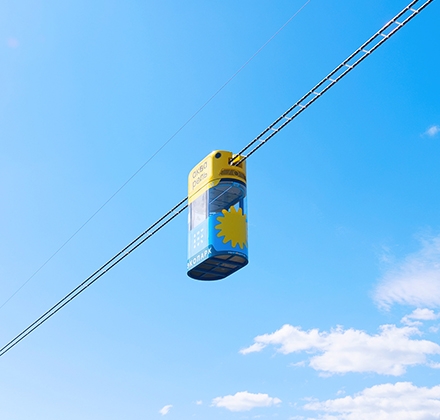
uLite U4-830
Double-rail suspended uPod of simplified configuration. The cabin can be implemented both for passenger and cargo transportation. uLite was designed as the most cost-effective rolling stock version. The key points in the development of model were the ease of manufacture and the minimum amount of equipment: only necessary for the smooth operation, safety and ergonomics of transport. It can be used for various purposes – as a public transport, on tourist routes, for connection with sparsely populated and remote areas.
Features

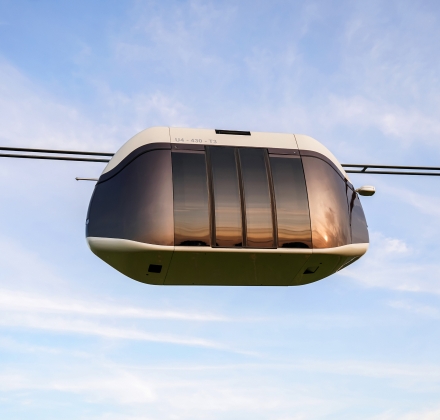
uCar U4-430
Double-rail suspended uPod of increased comfort for city and suburbs. The cabin is made by analogy with the car one, only seats are provided. Multimedia systems are installed. uCars can be assembled as modules by means of a rigid or electronic coupling into trains of a larger capacity. Depending on the customer expectations and the required volume of traffic, the number of sections in the train can vary from 2 to 7.
Features
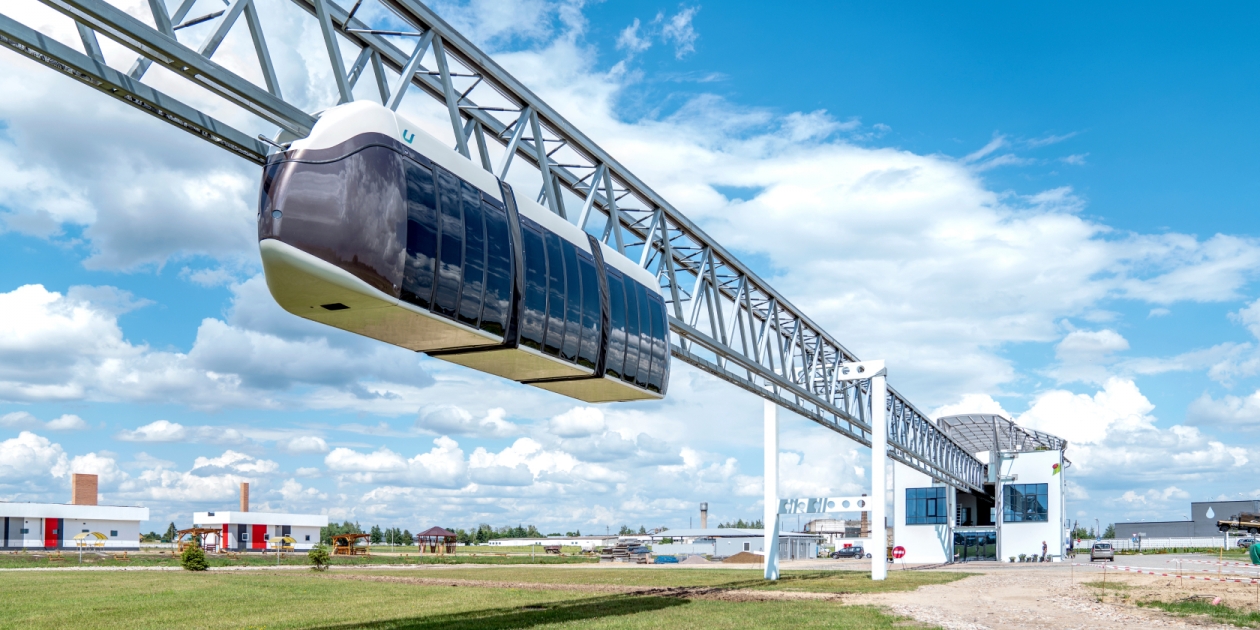
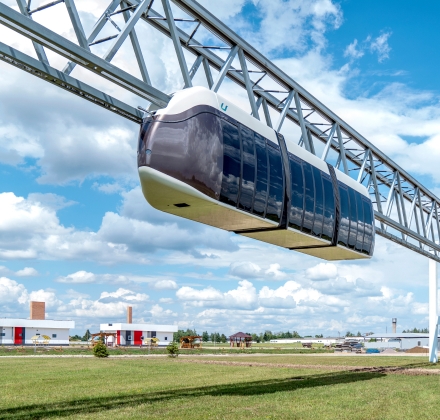
uCar U4-430-Т3
Double-rail suspended three-section passenger uPod of increased comfort. It is made on the basis of a single-section uCar U4-430. The cabin is performed by analogy with the car one, only seats are provided. Multimedia systems are installed. The rail electric vehicle is designed to be used on urban and suburban routes.
Features
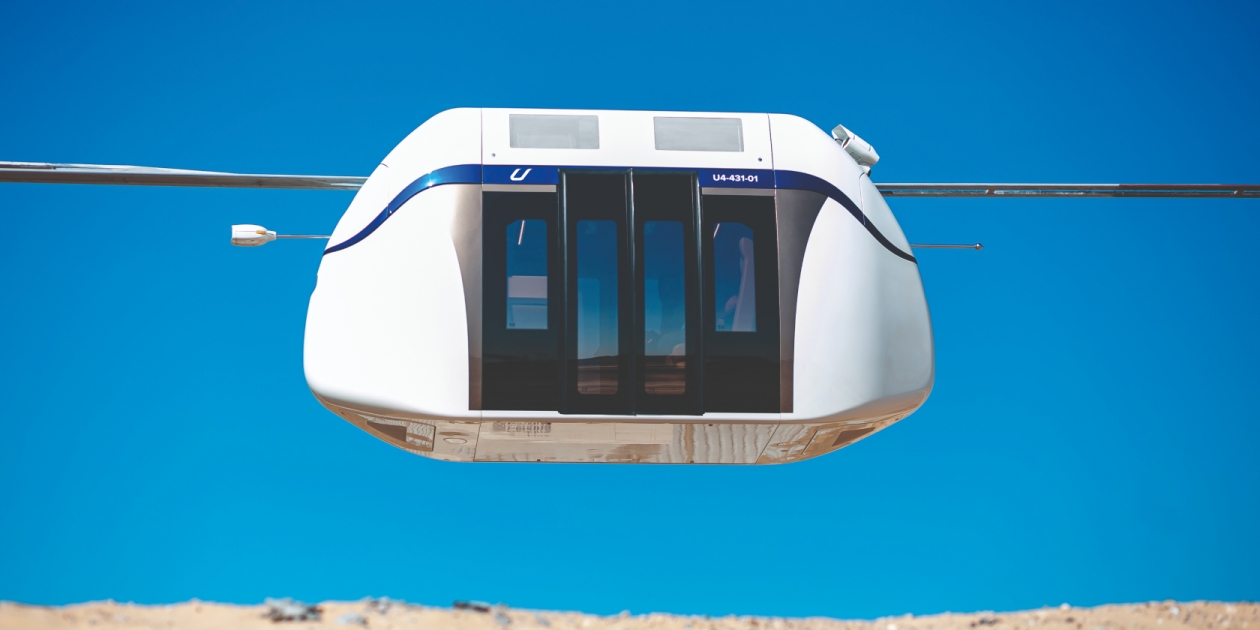
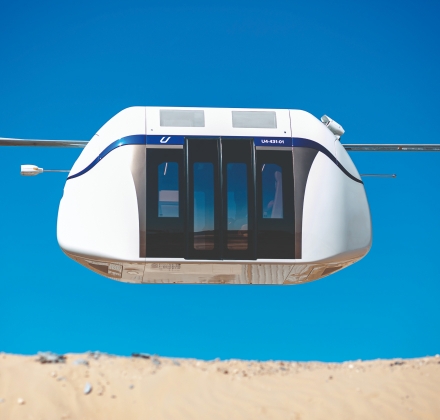
uCar U4-431
Suspended double-rail passenger uPod in VIP version for operation in tropical climate. It is based on the U4-430 model. The cabin is made by analogy with the car one and equipped with two main passenger seats of increased comfort with automated backrest incline adjustment. There are two extra places with folding seats, a folding table, a refrigerator, cup holders. A multimedia system with a 32 " screen diagonal is installed, as well as a more powerful acoustic system in comparison with the basic version. Air-conditioning and microclimate systems ensure uninterrupted operation of uCar and comfortable conditions for passengers at an ambient temperature of up to +60 °C.
Features
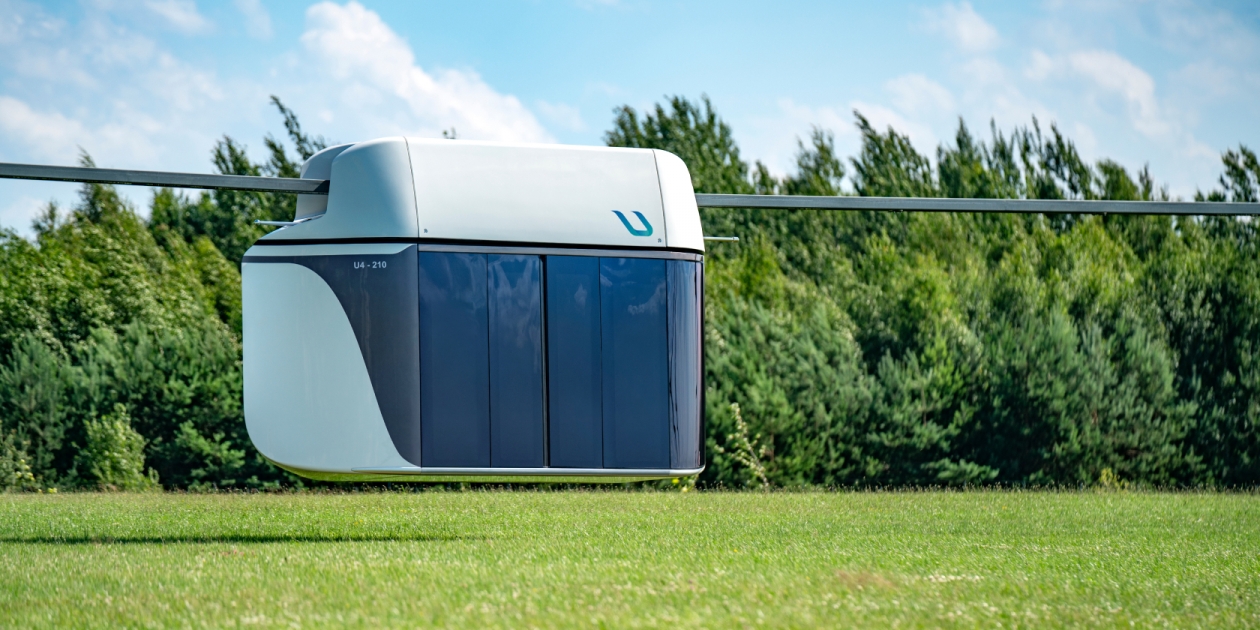
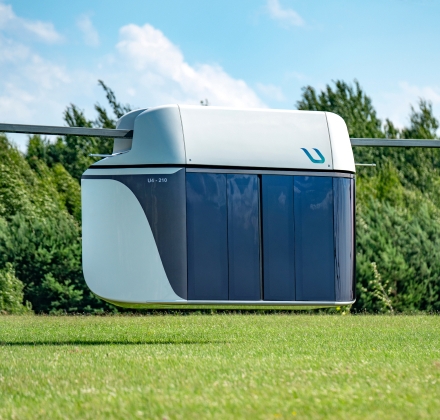
uBus U4-210
Double-rail suspended passenger uPod for city and suburb routes. uBus can be single, as well as it can be a part of train with a various number and type of constituent units. It is equipped with audio and video information systems for passengers, climate control and other additional functions. There are places for people with disabilities.
Features
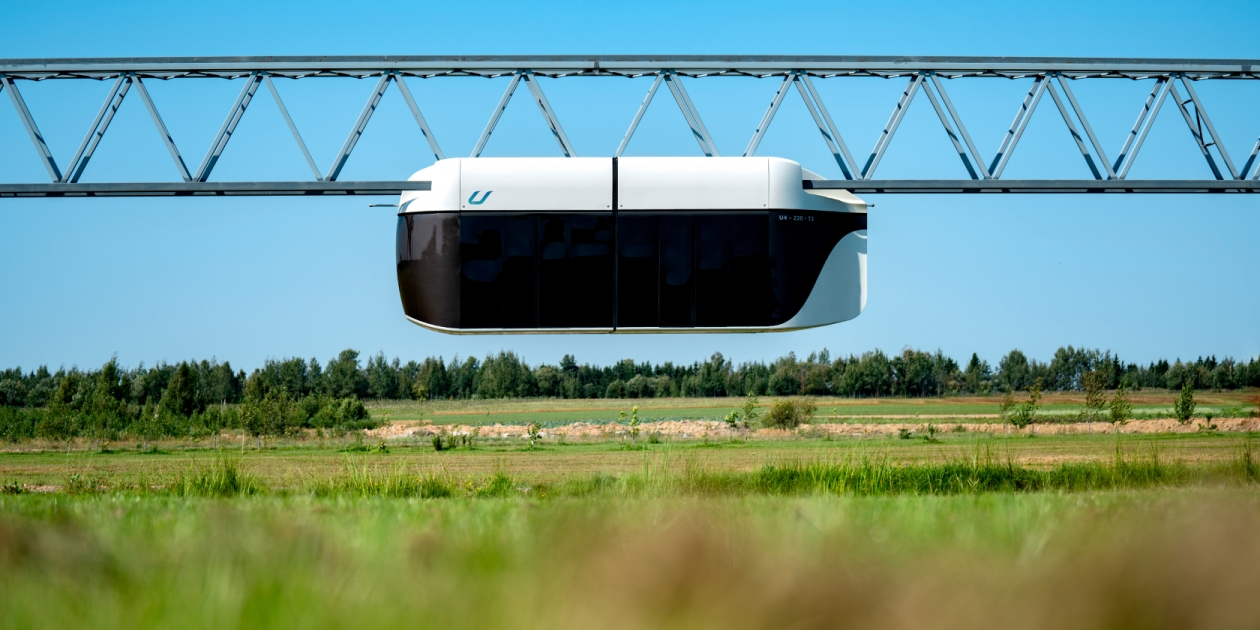
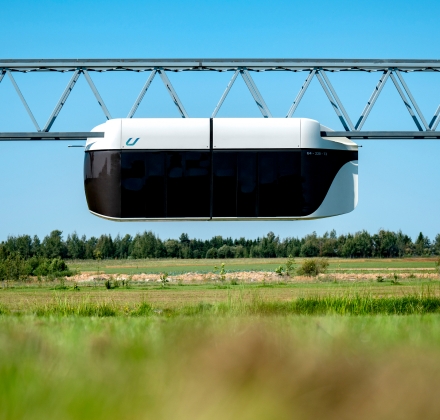
uBus U4-220
Four-rail suspended passenger uPod for transportation on city and suburb routes. It consists of two modules and allows to significantly increase the productivity of the transport and infrastructure complex during periods of intensive passenger traffic. An electric car on steel wheels is equipped with audio and video information systems for passengers, climate control and other functions.
Features
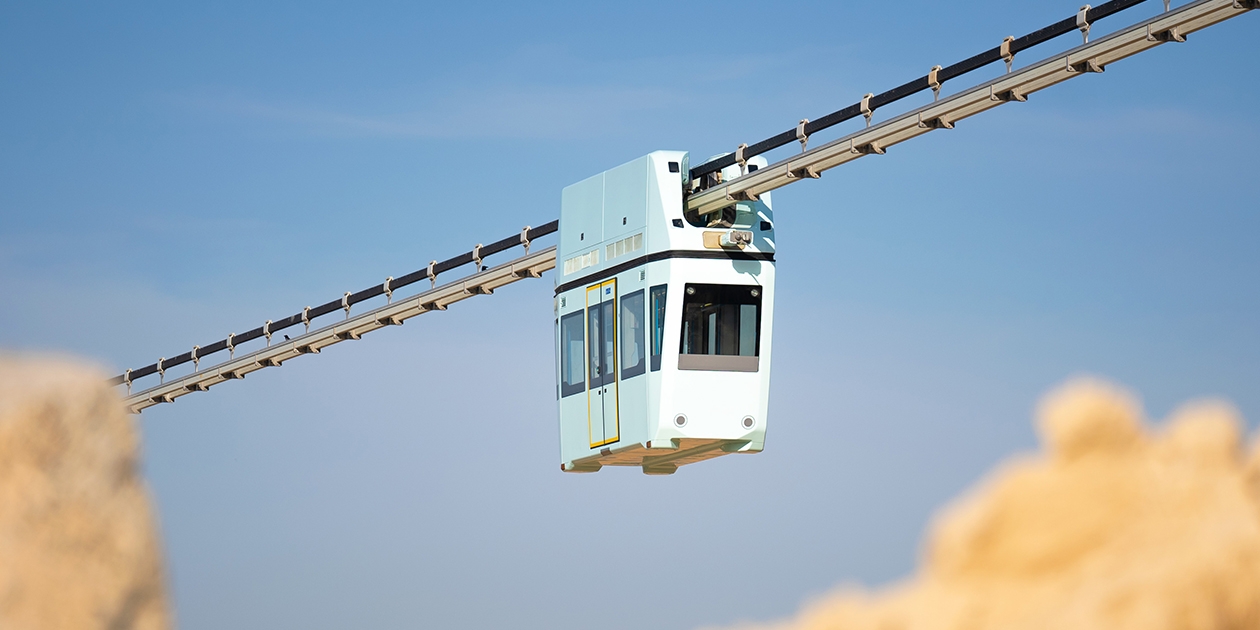
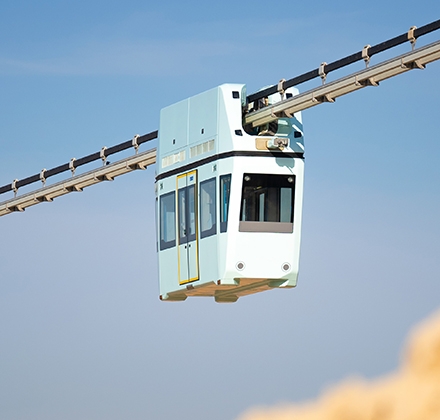
uBus KARAT U4-212
Double-rail suspended passenger uPod of increased capacity in tropical version. The cabin is adapted for passengers with disabilities, a place for the transportation of wheelchairs is provided. The glazing configuration offers a 360° view to passengers. uPod is equipped with a multimedia system and Wi-Fi. It is designed for use on urban and suburban routes in arid climates. Air-conditioning and microclimate systems make it possible to ensure uninterrupted operation of the rail electric vehicle and comfortable conditions for passengers at extremely high temperatures.
Features
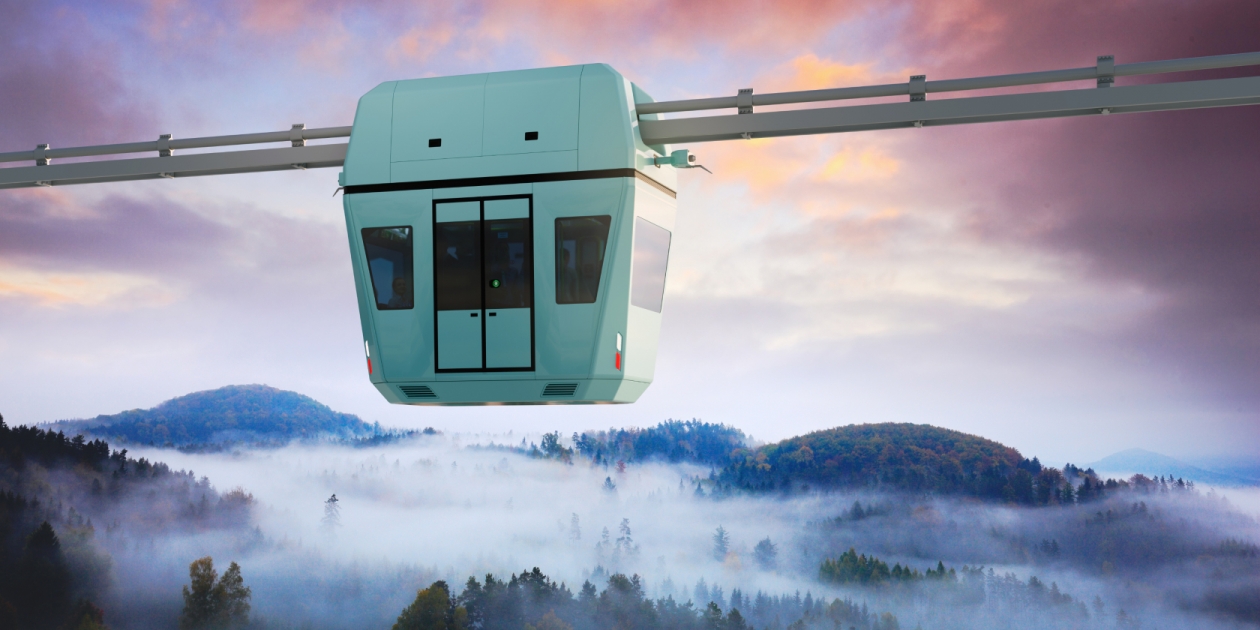
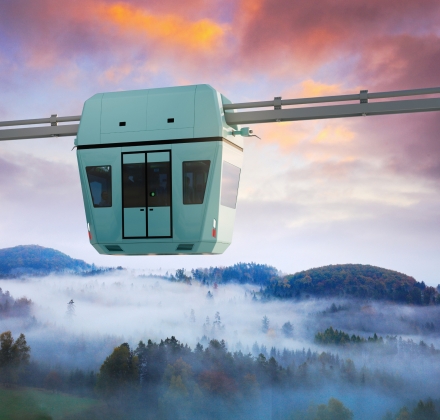
uBus KARAT U5-543
Double-rail suspended passenger uPod with panoramic view. There is a place for a wheelchair in the cabin. The glazing configuration offers a 360° view to passengers. uPod is equipped with a multimedia system and Wi-Fi. It is designed for transportation on urban and suburban routes.
Features
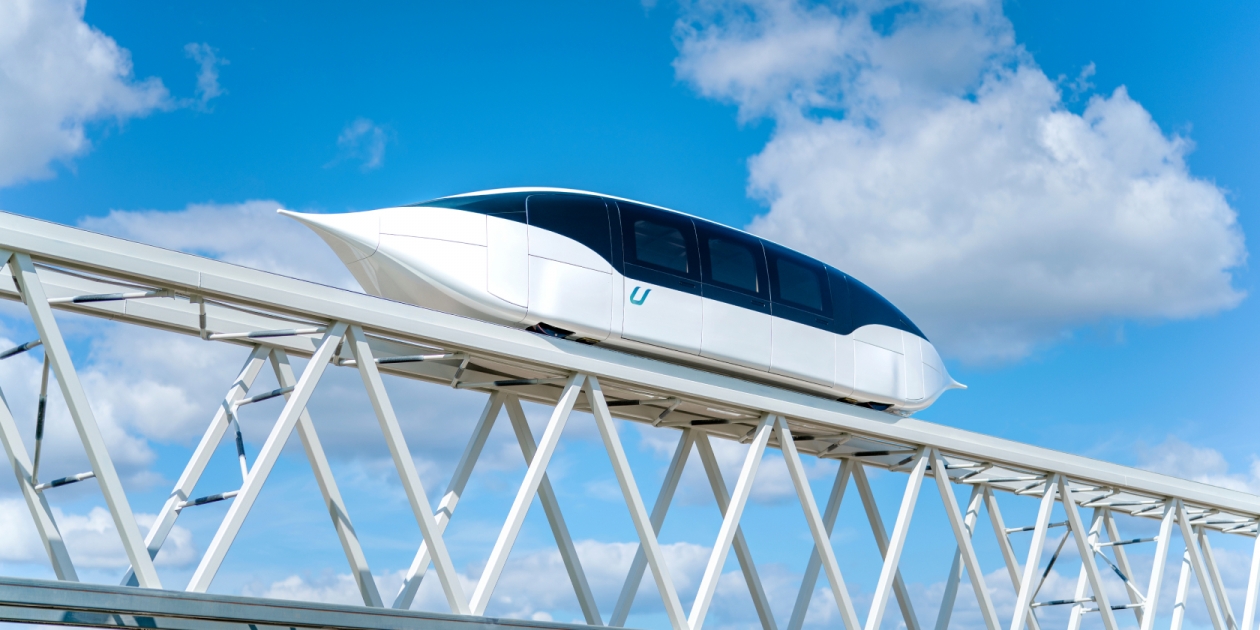
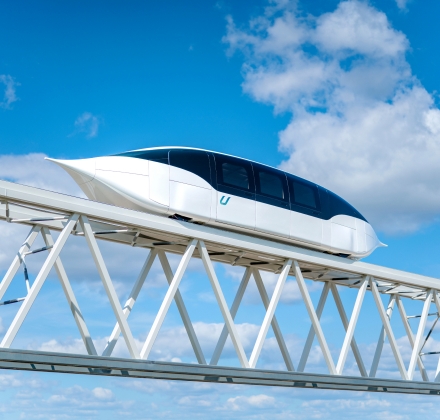
uFlash U4-362
Double-rail suspended high speed passenger uPod. Designed for intercity and international transportation of passengers (and cargo). Comfortable seats with adjustable backrests are provided. Multimedia systems and air conditioning systems are installed. The high speed of movement is ensured by the unique aerodynamic contours of the uPod body. The aerodynamic characteristics of uFlash U4-362 are close to the theoretical limit: drag coefficient Сх is equal to 0.06. uFlash is equipped with luggage compartments.
Features
Cargo Transport
-
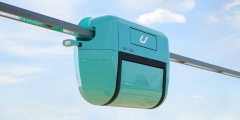
uTruck U4-131
-
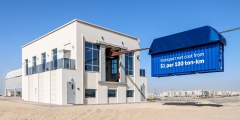
uCont SPC 212
-
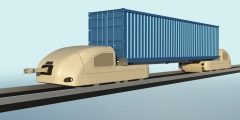
uCont U4-192
-
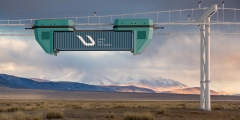
uCont U5-247
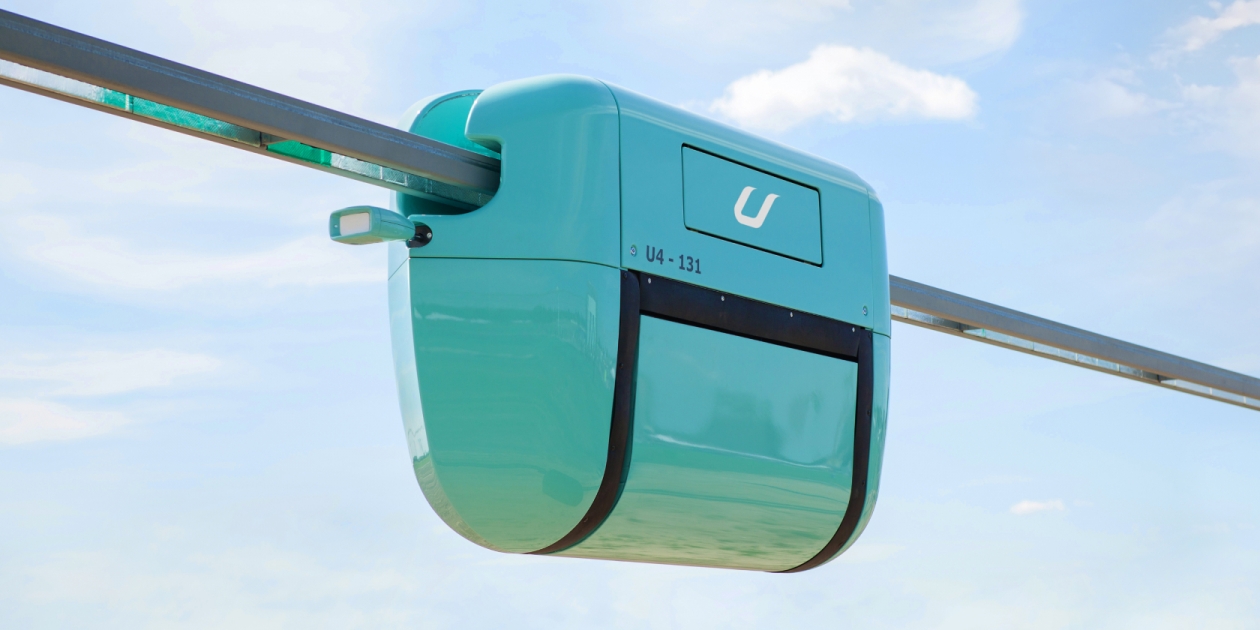
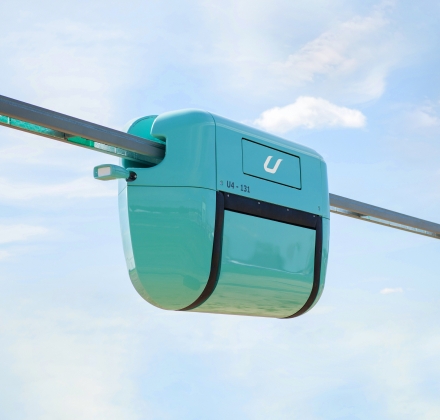
uTruck U4-131
Double-rail suspended cargo uPod intended for transportation of bulk, piece, liquid, dangerous and perishable cargo. Loading and unloading of uTruck can be prformed automatically. The rail electric vehicle is designed for use in industrial facilities, ports and mining sites.
Features
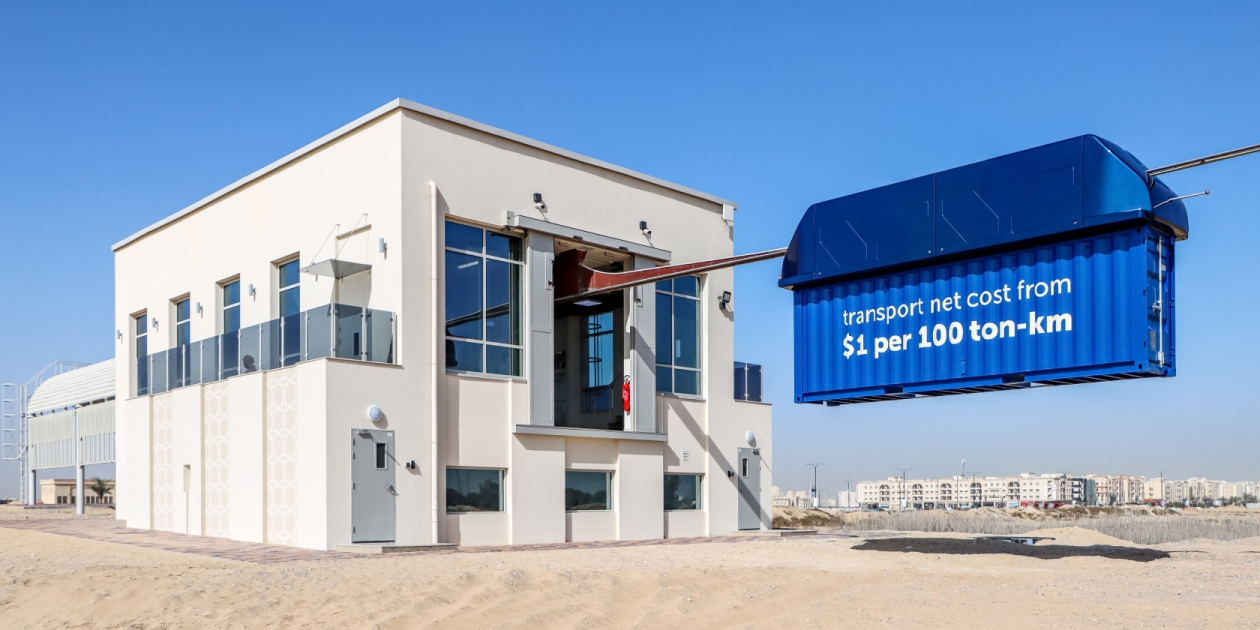
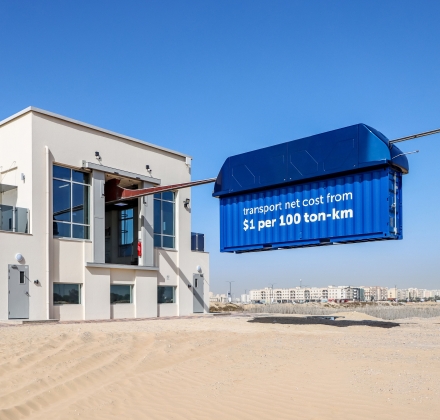
uCont SPC 212
Double-rail suspended cargo uPod. It is intended for transportation of special containers in tropical climatic conditions. The rail electric vehicle can be used to carry out cargo transportation tasks at industrial facilities, ports and mining sites.
Features
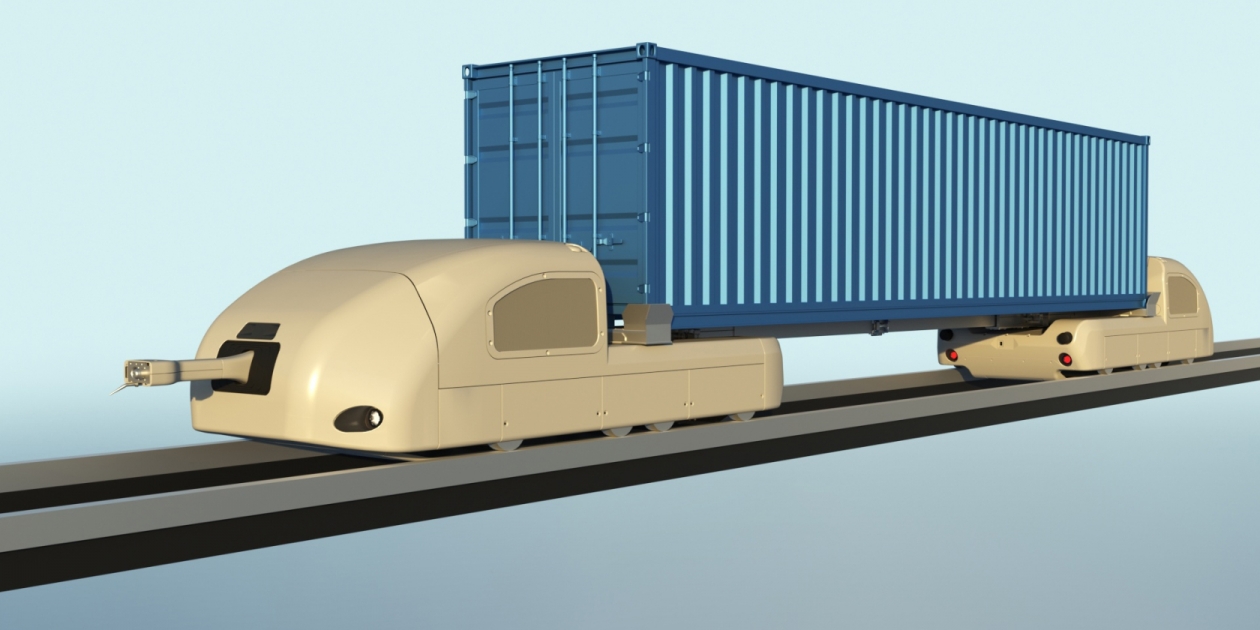
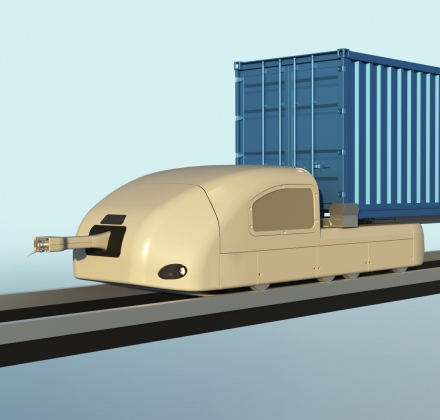
uCont U4-192
Double-rail suspended cargo uPod designed to transport 20- and 40-foot cargo containers in tropical climate. The design allows transporting large containers of any type without additional reloading. uPod can be used to solve transportation problems at industrial facilities, ports and mining sites.
Features
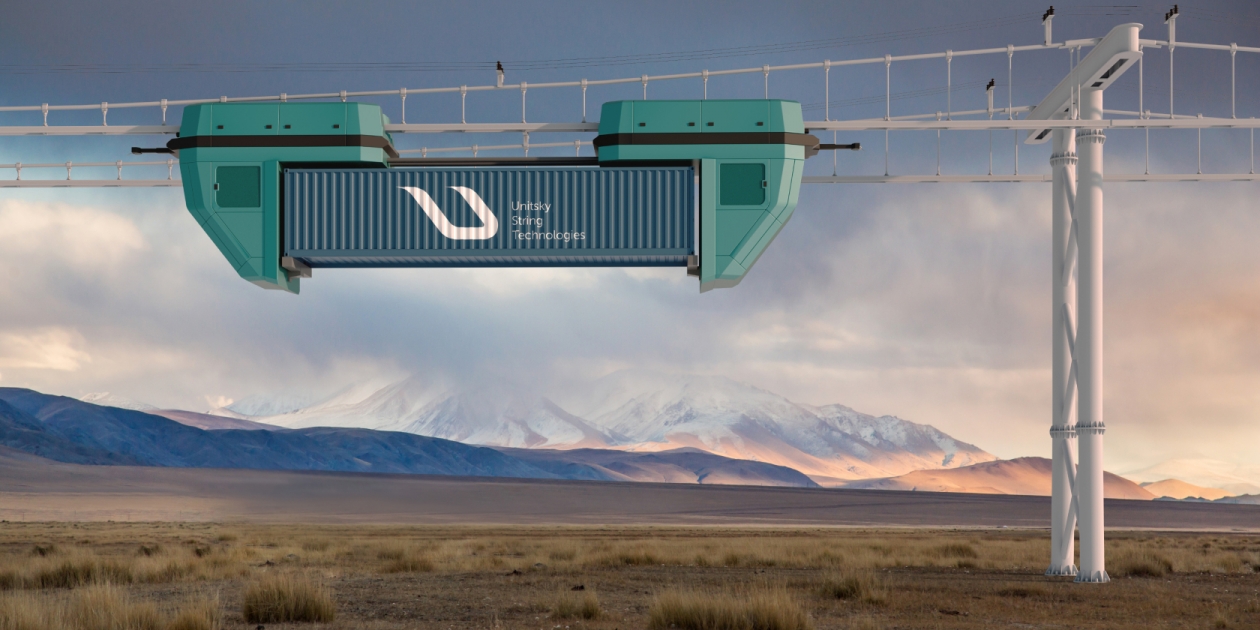
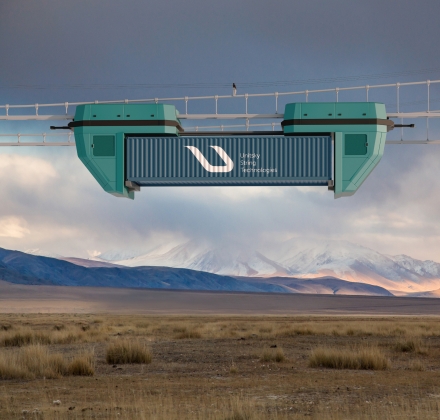
uCont U5-247
Double-rail suspended cargo uPod designed to transport 20- and 40-foot containers. It provides high performance and reliability of processing large volumes of incoming (outgoing) cargo flows in terminals, which are united in the uST automated complex. The scope is transport logistics hubs and port transport infrastructure facilities. Loading and unloading of containers can be carried out both in specialized terminals and with the help of a gantry crane or a port loader – a reach stacker. The uCont design allows to transport large-sized containers of any type without additional reloading.
Features
Unitsky String Technologies Inc.
Project application- Main office
- Legal address
- Press Center
220089, Republic of Belarus, Minsk,
st. Zheleznodorozhnaya, 33
Phone: +375 (17) 388 20 20
Fax: +375 (17) 388 06 06
email: [email protected]
222838, Republic of Belarus,
Minsk region, Pukhovichi district,
35 Novosyolki Rural Council,
Zorny Shlyakh St. area,
Maryina Gorka
email: [email protected]
Phone: +375 17 388 20 20, ext. 1308
Thank you for your interest in uST Transport & Infrastructure Solutions. For more information, please include your contact details and answer a few of our questions. Use the online form below.
Please answer all questions, if possible, so that we can provide a more complete answer for you.
Please fill out one form for each project individually.
Failed to submit form
Try again
The minimum traffic interval is based on the applicable requirements that ensure a necessary level of safety. On the one hand, by the on-line traffic speed, and on the other hand, by the length of the station platform and the time of embarkation and disembarkation of passengers. For single uPods this interval is 25-30 seconds. uPods that are electronically coupled in a train can leave the station one after another with a minimum interval of 2-3 seconds (this is, for example, the interval of cars on the autobahn).
uST Transport & Infrastructure Complex can operate 24/7 on intercity lines (as on railroad) and 20/7 on city lines (as in subway).
Yes, they are GoA4 in the grade of automation (IEC 62290‐1) – unmanned, with central control.
uPods can be located both in special holding stations (“parking lots”) and on the spare lines of stations and in the garages with repair shops (depending on the performance of uST Transport & Infrastructure Complex). During off-peak hours, electric rail cars, if necessary, are removed from the line with the help of appropriate infrastructure components and placed in special holding stations or in service and repair areas.
There are no structural limitation, and the only one is the vertical curvature radius of the track over the support, which determines centrifugal accelerations (no more than 1 m/s2), and thus the comfort for passengers when passing a support. For instance, for a speed of 500 km/h, both horizontal and vertical track curvature radii (including on supports) must be at least 20,000 meters. The combination of structural solutions in uST string rail overpass and rolling stock includes the support saddle, high bending stiffness of the track structure, highly tensioned holding rope, and pneumatic suspension of the wheels, which ensures any required traveling smoothness of uPods, including when passing a support. If necessary, the support section can have reverse curvature of the track (concave curve with bending in the middle of a span), that is the passenger not only will not feel overloads, but on the contrary, his weight will decrease to some extent when passing a support.
Unfortunately, you cannot be 100% sure to guarantee that any component will not fail. However, so far, we have not yet recorded a single malfunction in power supply. The onboard traction electric drive is equipped with a mature cooling system that has independent loops, the products are tested in climatic chamber, the tropical uCar has been successfully operated in the UAE for more than three years already.
We should also highlight that a failure of the traction power supply (e.g., electric substation) will not stop the traffic on the line. Even a failed part of the electric drive system won’t stop the complex, as each system in it is duplicated. Besides, if there are any power supply problems on rails, the onboard emergency battery of uPod will produce enough power for at least 100 km of journey.
Yes, uPod can move at the same speed in reverse direction as a shuttle. The movement direction of the rolling stock is determined by the design of the undercarriage, suspension systems, traction electric drive control systems and the external contours of the body. The main types of uPods will be operated without any reference to directionality, as this solution is universal, which also allows reducing the operating costs. At the same time, of course, there are also solutions with unidirectional movement, which is a priority in a number of projects, especially with large passenger and cargo flows.
uST Transport & Infrastructure Complex can be designed both for operation in freezing climate (down to -60 °C) and for in tropical conditions (+50 °C with extension of operating temperature up to +55 °C).
Today, string transport is operated both in temperate climate (the bottom temperature limit is -40 °C in Belarus) and in the tropics (up to +55 °C in the UAE).
As for rainfall, uPods are undergo sprinkling tests with rainfall intensity of at least 2-3 mm per minute, which corresponds to a heavy tropical downpour.
Humidity is up to 100% inclusive under appropriate conditions of the climatic region.
Wind stability for the complex to operate in a standard version is 90 km/h (25 m/s). Anything higher – up to 250 km/h (70 m/s) – is possible in a special version based on customer requirements.
Probably. Our uPods are prepared and already operated in harsh conditions, including sandstorms, in Sharjah (UAE). The possibility of operation is ensured by a number of structural solutions in the infrastructure components of the string rail overpass, rolling stock, including a mature filtration system and installation of various cleaning systems. Such systems include, for example, a device to clean the rolling surface of the rail from stuck sand or the traction module blowing system.
Prestressed strings are elements in which tensile stress state is created in various ways, so in its design essence it is a prestressed bearing reinforcement. The company mainly uses reinforcing ropes.
The vertical load is distributed to supporting towers, installed at intervals of up to 2 km. The string rail track structure looks light and delicate: it does not block the sky and preserves natural landscapes along the route of laying tracks.
The strength of a string rail in such structures is ensured by choosing materials with certain strength characteristics, selecting the necessary rigidity and creating a tensile prestress state, which holds the superstructure.
- Flexible – standard payloads up to 20 tons, speeds up to 150 km/h and long spans up to 2 km that can reach up to 5 km when using composite strings, such as carbon fiber.
- Rigid – maximum payload up to 100 tons, high-speed modes up to 500 km/h, short spans up to 60 m.
- Semi-rigid – increased payload up to 30 tons, speeds up to 350 km/h, short spans up to 60 m.
- Semi-flexible – a combination of semi-rigid and flexible – increased payload up to 50 tons, high-speed modes up to 500 km/h and long spans up to 2 km that can reach up to 5 km when using composite strings.
The most material-intensive and expensive overpass of the listed ones is rigid, while the lightest and most inexpensive is flexible.
The energy consumption of uPods is 2–3 times lower than in traditional modes of transport using steel wheels or a magnetic cushion. If we compare this figure with road transport, including a traditional electric car on pneumatic tires, then it is 5–7 times lower.
Conventional electric vehicles use pneumatic tires, which, when worn together with asphalt, emit soot, benzopyrene, phenols and other carcinogens (more than 100 of them) into the air, while some carcinogens are contained here in greater quantities than in automobile exhaust. At UST Inc. this problem is solved due to the use of steel wheels of a special design – more efficient, for example, in comparison with railway wheelsets.
A uPod is more environmentally friendly than a traditional electric vehicle, which consumes several times more electricity and takes up space on a city road, which leads to traffic jams in which toxic substances are released. uST vehicles move above the ground and eliminate the problem of traffic jams.
Noise and vibration from uST transport is significantly lower than from a railway, tram or monorail. It has already been studied that, for example, in the Moscow metro, the presence of a passenger will be safe only for the first three seconds. Further, negative factors begin to affect the human body – an isolated and compressed space, powerful electromagnetic radiation, as well as the strongest noise and vibration. While uPods do not have even a small share of such a negative impact on a person.
uPods, including those assembled into trains, can have different capacities – from 2 to 250 passengers. Their design is separate modules, combined into a composition through a rigid or electronic coupling. Such a train is capable of transporting up to 50 thousand people per hour, that is, at the level of the metro and the railway. The number of sections and their capacity depends on the passenger flow. The uPod is driven by a traction electric drive. Speed and route control are provided by automated control systems.
uST transport can carry different types of cargo: bulk, liquid, piece, special, as well as sea containers with a nominal length of 20 and 40 feet. Their loading and unloading occurs automatically. Speed and route control are provided by automated control systems. Cargo transport is capable of carrying up to 100 million tons of cargo per year.
The string rail overpass is located above the ground, so collisions with ground vehicles (buses, cars or agricultural machinery), pedestrians or animals are impossible. The prestressed track structure maintains the operability of the uST complexes even if one or more supporting towers are damaged in the event of natural disasters or other force majeure circumstances. In such a situation, the string rails will sag more, but they will not break and their performance will not be impaired. The collapse of the track structure is also excluded in case of damage and rupture of individual strings (up to 50% of their total number), for example, as a result of a terrorist act.
Features of the uST transport and infrastructure complex elements make it possible to use it in regions with difficult climatic conditions. Pre-tensioning of rails solves the problem of temperature deformations and allows transport to operate at abnormally high and low temperatures.
The change in the characteristics of the rails under the influence of temperature is included in the project so that it does not affect the performance of the uST complexes, as well as the speed limits and the comfort of transportation. When the temperature changes, the length of the string rail does not change – the structure is prestressed and only the tensile stresses in the rail change, which ultimately makes it possible to abandon the expansion joints that affect the performance properties. The safety margin of strings is such that they will be broken only if they are cooled to the temperature of liquid nitrogen – about −200 °C.
The uST transport overpass in terrestrial conditions is designed for a temperature difference of 120 °C: from −60 °C to +60 °C. It is resistant to snow drifts up to 10 m high, icing and sandstorms, floods up to 10 m high and tsunamis, heavy rains and fogs, storm winds up to 250 km/h, earthquakes of 9 points on the Richter scale and other extreme impacts, including vandalism and terrorist acts, if such impacts are considered probable in the project, even with a probability of once in 100 years.
Control system for uST transport and infrastructure complexes is automated. Using the technical vision of the uPod onboard control system, they continuously read information from the track structure, monitor the fulfillment of the route task, and also instantly respond to obstacles and threats. Their task is to ensure comfortable and safe transportation of passengers, as well as reliable and trouble-free transportation of goods.
The systems receive, process and analyze information thanks to sensors and fully control the route and speed of movement, independently make decisions to reduce speed or stop if obstacles are detected on the route. It provides for real-time data exchange with elements of the transport and infrastructure complex, as well as obtaining up-to-date information from other uPods.
Automated systems provide control over the state of safety in the uPod cabin and coordinate the processes of embarkation and disembarkation of passengers. The systems are able to recognize the actions of passengers that may pose a safety risk and take measures to prevent dangerous situations. For example, acts of terrorism and vandalism.
The number of personnel required to maintain the operation of the complex is determined individually for each project, but it is much less than, for example, on a traditional railway or on high-speed roads with a magnetic cushion. uST facilities need mechanical engineers, telemetry and communications engineers, locksmiths, mechanics, security guards, and other traditional professionals.
The costs for the construction of a specific uST transport and infrastructure complex depend on the planned volume of traffic, estimated speeds, the nature of the terrain and climatic conditions, the type of logistics tasks and, accordingly, the design option. At the same time, factors such as the total length of the route are important (the longer it is, the cheaper the subsequent kilometers), the terrain (plain, sea shelf, foothills, mountains), the height of the supports (the higher the path is placed, the more expensive it is), the strength of the underlying soil (sand, rocky soil, swamp), the presence of obstacles (rivers, lakes, gorges), etc.
Compared to existing overpass transport solutions (monorail, cable car, light rail transport, high-speed tram, metro, etc.), the cost of construction and operation of uST complexes is several times lower, primarily due to a decrease in the material consumption of all elements of the complex, as well as due to reducing the construction complexity. In the production of rolling stock, i.e. rail electric vehicles on steel wheels, a small consumption of structural materials is also required. The absence of massive drives, powerful frames, heavy undercarriages and wheelsets significantly reduces the cost of rolling stock production.
Resistance to external influences and durability of the string rail overpass provide low operating costs. Regular replacement of the complex elements is not required, while service intervals are significantly increased in time and mileage. The service life of the overpass before overhaul is from 50 years, while for the rolling stock this figure is from 25 years.
Maintenance of the transport complex requires work on pre-trip inspection of rolling stock and interval inspection of track structures by automatic devices as well as periodic testing of the control system with related subsystems.
It is easier to integrate a string rail overpass into an already formed urban environment than to build a new metro, railway or highway. The light string rail track will harmoniously fit into the architecture of any settlement, cross city streets, roads and rivers, and, if necessary, pass over parks and low-rise buildings. Existing communication networks can be integrated into the transport overpass, no radical re-planning of the city infrastructure is required. Passenger stations are combined with anchoring structures. Stations can be used as commercial real estate, placing cafes, shopping and entertainment centers, hotels, pharmacies and other facilities in them. Stations can also be used as additional advertising space. Due to this, the payback period of uST complexes is reduced.
The capacity required to power uST systems varies by project. Depending on the logistics, the number of stations, length of the complex, passenger traffic, traffic speeds, and power consumption will be determined. In any case, uPod fleet, with similar transport work, will require approximately 5 times less primary energy (starting from fuel combustion in a power plant) than, for example, a Tesla electric vehicle fleet.
Therefore, uST is the “greenest” transport of all possible, including in comparison with traditional electric vehicles and magnetic levitation trains.
Transport and infrastructure complexes of Unitsky String Technologies are characterized by almost zero environmental impact and low noise level. Electric rail vehicles on steel wheels run on the most environmentally friendly form of energy – electricity. Transport should peacefully coexist with nature, and not be at enmity with it, complement it, but not replace it – this is the approach the company adheres to when developing its solutions.
Ecologically clean string rail roads are dotted on the ground. This advantage, with the widespread use of transport and infrastructure complexes, can save vast territories for land users, which would otherwise be occupied by traditional transport communications. For example, under roads and railways, soils which area is five times bigger than the territory of Great Britain have already been destroyed on the planet. Vegetation will remain in the areas saved by uST, annually replenishing the atmosphere with billions of tons of life-giving oxygen. The severity of environmental pollution problems will then decrease to a safe level.
UST Inc. is an engineering company primarily that has the status of a scientific organization in Belarus. Our employees are involved in the development, production, service, testing and marketing of our uST transport and infrastructure complexes. The company is developing due to its investors who believe in technology and its scaling, launching global projects in different countries and continents. They do not invest directly, but through special crowdfunding platforms.
The competitors of UST Inc. are transport systems of the “second level” above ground, such as cable cars, light rail transport, elevated and underground metro, monorail, trains on a magnetic or air cushion. The main advantage of uST is the significantly lower cost of the transport and infrastructure complex with lower operating and transportation costs.
Any transport is created for the sole purpose of providing a transport service, where the following criteria are decisive: the cost of service, the safety of service, the availability of the service (in time and space), its comfort, energy efficiency, resource intensity, environmental friendliness, etc. As for the complex of these parameters, so and for some of them, uST has no equal among the listed and promising competitors. Behind this are not emotions, but the laws of physics.
The uPod must be removed from the route to perform additional checks and determine the causes of the breakdown. However, the probability of such a risk is extremely low. The main systems that ensure a safe transportation process have multi-circuit redundancy. In addition, the rolling stock is equipped with systems that make it possible for its automated evacuation by neighboring uPods located on the line. The uST complex also provides access for special equipment (module with tow device) and maintenance personnel to perform forced evacuation.
Emissions of harmful substances in electrified uST complexes are practically absent, amounting to only 0.1 g/pass-km. This is especially noticeable against the background of traditional modes of transport. On high-speed railways this figure is approximately 0.6 g/passenger-km. Vehicle emissions of harmful substances are on average more than 10 g/pass—km. Aviation pollutes the atmosphere the most. If we take modern aircraft, the total emission of harmful substances reaches 300-400 g/pass-km.
uST transport is virtually silent even at high speeds. The exceptionally quiet and smooth rolling of the steel wheel is ensured by several factors:
- No gaps in rail joints
- Presence of internal and support dampers
- Low unsprung weight of the undercarriage and multi-stage independent springing
The friction forces in the steel wheel-steel rail head pair will ensure a steady rise with a slope of up to 15% if all wheels of the uPod are driven. At climb angles of 20-30%, each uPod must be equipped with an additional group of rollers that create the required coupling force for a given section of track.
Each electric rail vehicle can be assembled into trains by means of a rigid (physical) or electronic (control system-based) coupling.
Standard power is supplied from the contact network on electrified sections of the track and from an energy storage device on non-electrified ones. In the event of a drive failure in an unelectrified section, the transport will be slowed down. Information about the malfunction will be sent to the central control system. If the uPod is unable to continue driving on its own, it will be towed to the nearest station for disembarking passengers, and then to a garage combined with a repair shop.
The uST solution allows you to transport:
- Oil, petroleum products and other liquid cargoes
- Coal, ore and other bulk cargoes
- Timber, building materials and structures
- Containers, furniture
- Food products
- Rolled metal products
- Chemical products
- Special cargoes, etc.
The terrain is not important for the uST complex, so the route will take the shortest path — in a straight line. If necessary, the track structure can have curvature in both the vertical and horizontal planes.
Overloads on curves should not be felt by passengers, therefore, the radii of curvature of the route for a speed of 300 km/h should be at least 10 km, for 400 km/h — at least 15 km, for 500 km/h — 20 km. For smaller turning radii of horizontal curves, bends performing is provided. Curves can have a radius of, for example, 1000 m, but then on these sections of the route the speed should be no more than 100-150 km/h.
The minimum radius of the curves is 10 m (at stations, terminals, or garages combined with a repair shop, where the speed of electric rail vehicles is close to zero). At the same time, on curved sections of the route with a radius of less than 100 m, the rail will be made without strings (according to the type of railway rails) and supported by beam or truss superstructures of both conventional design and string type.
The anchor structure can be combined with turns at the station or be common to two track structures at the turn.
Electric rail vehicles provide for an independent emergency evacuation in case of force majeure, when there is nowhere to wait for help: an earthquake, a terrorist attack, etc.
The passenger module is equipped with a rope-lowering rescue device of the tow truck type (for small-capacity uPods carrying up to 25 people), so that any passenger can descend to the ground.
Each large-capacity uPod (carrying more than 40 people) is equipped with a rescue sleeve and a folding ladder, which will also ensure the rapid evacuation of people from the aboveground “second level”, if necessary.
In addition, the emergency electric drive and control system in such cases will ensure that uST transport stops not in a random place, but precisely where it is possible for passengers to safely descend to the ground.
It is impossible to name a fixed figure, since the cost of building 1 km of the uST track is influenced by the following factors:
- Is it a single- or double-track
- Is it a high-speed or low-speed track
- Is it an urban or an intercity track
- Is it a passenger, cargo, or both passenger and cargo track
- Is it a mounted or suspended track
- Is it an ultralight, light, medium, heavy or super-heavy class track
- Frequent or rare location of stations, train stations, cargo terminals and other infrastructure elements on the route, the number of vehicles on the line (organization of storage)
- Natural and climatic factors of the region of operation (passage of the route through the plain, sea shelf, tundra, permafrost, desert, mountains)
- Is the track structure located on low or high supports
- Development of the region’s infrastructure, transport accessibility
At the same time, the cost of building 1 km of the uST complex transport overpass, other things being equal (i.e. climatic and infrastructural conditions), will be: from 50% of the cost of building 1 km of cable car, from 10% of the cost of building 1 km of light rail overpass, from 4% of the cost of building 1 km of subway.
If necessary, the station can be integrated into an existing building, taking into account the assessment of economic and technical feasibility.
There will be no longitudinal temperature deformations at all — neither in the body and the rail head, nor in the string. After all, their length remains unchanged in summer and winter. The rail and the string a priori do not have temperature deformation seams along their length, just as telephone wires or power line wires do not have them, which, like the strings in the rail, are sagging between supports and stretch without joints for many kilometers.
However, it should be borne in mind that a change in temperature in the structure can lead to changes in its stress-strain state. Therefore, the uST track structure is designed so that only tensile forces are present in the rail and string at any calculated temperature changes. In this exact case the structure will never lose stability, which would’ve happened if compression forces appeared in these elements.

